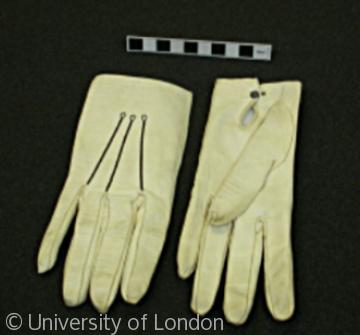Glove-making in Ledbury

©Hereford Museum
A fine pair of leather ladies' gloves, nineteenth century
Gloves had been made throughout the Middle Ages, but became increasingly fashionable and widespread in the sixteenth century. Most of the gloves were of heavy leather and were made for work wear, though finer gloves were also made. In the sixteenth-century knitted gloves were introduced. Some gloves had always been highly decorative, especially those for ecclesiastical use. Gloves also had symbolic significance and were ofen given as gifts. In 1579 the Bailiff of Ledbury paid 16 shillings for four pairs of gloves to give the the 'four benchers or judges' when they came to the town.
©Hereford Museum
Knitted men's gloves, seventeenth century, with slits in thumb and forefinger for handling coins
Leather glovemaking was a skilled trade. The London Glovers' Company was founded in 1349 and other cities also had guilds to regulate the trade and oversee the training of apprentices. Worcester was one of the most important centres for gloves in England, up to the present time. Worcester Museum has an exhibition about the gloving trade. Most market towns would have had a handful of glovers. In Stratford-upon-Avon William Shakespeare’s father, John, was a glover and wool dealer. The Shakespeare Birthplace Trust has an exhibition about him and information on glove-making in the sixteenth century .
When apprentice glovers neared the end oftheir training, they were expected to make apair of kid gloves so fine that they could berolled up inside a walnut shell.This example is one of two such masterpieces inthe Hereford Museum collection.
©Hereford Museum
Ledbury was rich in the three things necessary for making gloves: sheepskin, wood (for tannin) and water. There are records for medieval Ledbury which show people with the surname 'Glover'. By the last twenty years of the sixteenth century there were at least eight glovers in the town: Richard Barnet, John Chambers (also described as a corvisor), Thomas Daniell, Thomas Hooper, William Pricket, George Smith, William Stone, and Richard Symons. When Thomas Hall, plumber, died in 1602 he owed money to Thomas Roberts, a glover in Hereford. In the later seventeenth century we know of at least two two Ledbury glovers, John Lewis and Edward Adams.
©Hereford Museum
Fine white kid kid gloves, early nineteenth century
©Hereford Museum
A farmer's wife's long white cotton gloves, late 18thC.
The trade grew throughout the eighteenth and nineteenth century, reaching a peak in mid-Victorian times. This was driven by the fashion for ladies to wear a great varitey of types of gloves on many different occassions. By the early twentieth century glovemaking was concentrated in factories in centres such as Worcetser and Yeovil. There were no more glovemakers in Ledbury.
Bibliography
Beck, S.W., Gloves, Their Annals and Associations, Hamilton Adams & Co., 1883. (Useful on the history of gloves as symbols)
Clark, F., Challenge to Fashion. Gloves 1600-1979, Worthing Museum, 1979
Cumming, V., Gloves (The Costume accessories sereis) Batsford, 1988
Ellis, B.E., Gloves and the Glove Trade, Pitman, 1921
Lyes, D.C. The Leather Glove Industry of Worcester in the Nineteenth Century, Worcester City Museum, 1973
Salaman, R.A., Dictionary of Leatherworking Tools (1700-1950), George Allen and Unwin, 1986 (Chapter 7)
Waggett, Ralph W., The Worshipful Company of Glovers of London, Phillimore, 2000
Content generated during research for two paperback books 'Ledbury: A Market Town and its Tudor Heritage' (ISBN 13 : 978-1-86077-598-7) and 'Ledbury: People and Parish before the Reformation' (ISBN 13 : 978-1-86077-614-4) for the England's Past for Everyone series



